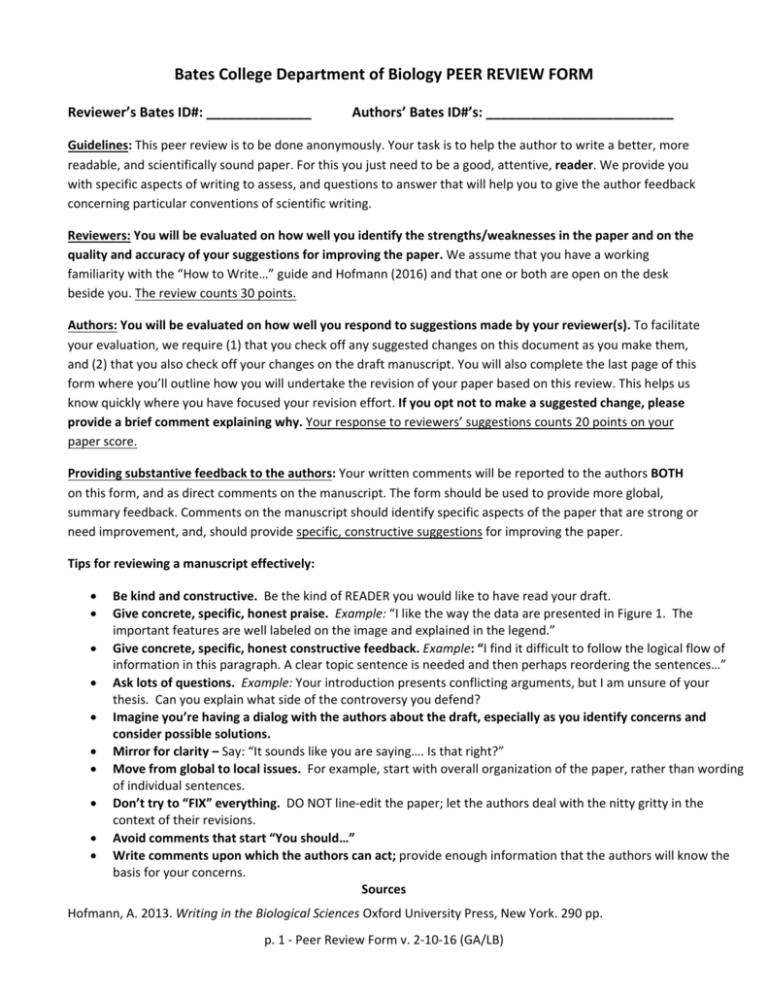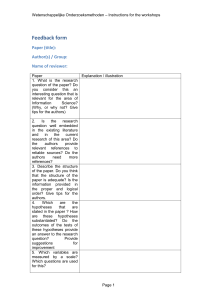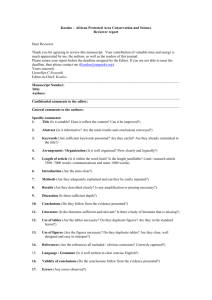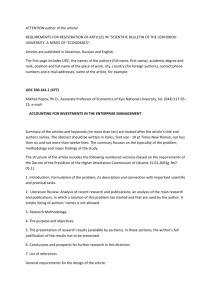Bates College Department of Biology PEER REVIEW FORM
advertisement

Bates College Department of Biology PEER REVIEW FORM Reviewer’s Bates ID#: ______________ Authors’ Bates ID#’s: _________________________ Guidelines: This peer review is to be done anonymously. Your task is to help the author to write a better, more readable, and scientifically sound paper. For this you just need to be a good, attentive, reader. We provide you with specific aspects of writing to assess, and questions to answer that will help you to give the author feedback concerning particular conventions of scientific writing. Reviewers: You will be evaluated on how well you identify the strengths/weaknesses in the paper and on the quality and accuracy of your suggestions for improving the paper. We assume that you have a working familiarity with the “How to Write…” guide and Hofmann (2016) and that one or both are open on the desk beside you. The review counts 30 points. Authors: You will be evaluated on how well you respond to suggestions made by your reviewer(s). To facilitate your evaluation, we require (1) that you check off any suggested changes on this document as you make them, and (2) that you also check off your changes on the draft manuscript. You will also complete the last page of this form where you’ll outline how you will undertake the revision of your paper based on this review. This helps us know quickly where you have focused your revision effort. If you opt not to make a suggested change, please provide a brief comment explaining why. Your response to reviewers’ suggestions counts 20 points on your paper score. Providing substantive feedback to the authors: Your written comments will be reported to the authors BOTH on this form, and as direct comments on the manuscript. The form should be used to provide more global, summary feedback. Comments on the manuscript should identify specific aspects of the paper that are strong or need improvement, and, should provide specific, constructive suggestions for improving the paper. Tips for reviewing a manuscript effectively: Be kind and constructive. Be the kind of READER you would like to have read your draft. Give concrete, specific, honest praise. Example: “I like the way the data are presented in Figure 1. The important features are well labeled on the image and explained in the legend.” Give concrete, specific, honest constructive feedback. Example: “I find it difficult to follow the logical flow of information in this paragraph. A clear topic sentence is needed and then perhaps reordering the sentences…” Ask lots of questions. Example: Your introduction presents conflicting arguments, but I am unsure of your thesis. Can you explain what side of the controversy you defend? Imagine you’re having a dialog with the authors about the draft, especially as you identify concerns and consider possible solutions. Mirror for clarity – Say: “It sounds like you are saying…. Is that right?” Move from global to local issues. For example, start with overall organization of the paper, rather than wording of individual sentences. Don’t try to “FIX” everything. DO NOT line‐edit the paper; let the authors deal with the nitty gritty in the context of their revisions. Avoid comments that start “You should…” Write comments upon which the authors can act; provide enough information that the authors will know the basis for your concerns. Sources Hofmann, A. 2013. Writing in the Biological Sciences Oxford University Press, New York. 290 pp. p. 1 ‐ Peer Review Form v. 2‐10‐16 (GA/LB) On‐line Biology Resources – Department of Biology | Bates College As you read the paper, check off the items below if they are addressed and well done. Circle those items that are missing or are not developed adequately. When possible, direct the authors’ attention to the specific location in the draft where the issue comes up. OVERALL CONTENT Purpose and Interpretation Is the overall purpose of the paper and /or central question clear? Does the interpretation of the findings answer the overall question of the paper? Support Is there sufficient evidence to support the answer/conclusion? Is every paragraph and sentence in the paper relevant to the overall question? Are there portions of the text that could be omitted? Overall Does the paper advance our understanding of the scientific question that was investigated? Does it provide interesting and important insights into the topic of interest? Have power positions (reporting most important information in the correct location) been considered (especially in the Introduction, Results and Discussion)? (see Hofmann 2016 if needed). ORGANIZATION Overall Organization – Global Aspects of the Paper Is the overall organization of the paper clear and effective? Are there disorganized parts? Could the clarity be improved by changes in the order of the paragraphs? Does the language seem appropriate for its intended audience? Individual Sections Introduction: Does the Introduction following a funnel structure (general specific)? Materials and Methods: Are experiments organized logically? Results: Is the main finding presented in the first paragraph? Are all Tables and Figures labeled properly? Discussion: Is the overall interpretation of the results stated in the first paragraph? Is the significance of the study stated in the last/concluding paragraph? Is the Discussion ordered in a way that is logical, clear, and easy to follow? References and Literature Cited: Have references been cited where needed? Are sources cited adequately, appropriately, and accurately? Are all the citations in the text listed in the Literature Cited section? p. 2 ‐ Peer Review Form v. 2‐10‐16 (GA/LB) On‐line Biology Resources – Department of Biology | Bates College INDIVIDUAL SECTIONS Title: WHAT DOES THE TITLE TELL YOU ABOUT THE WORK? Is the title strong? Does it effectively describe the paper? Suggestions for improvement: _______________________________________________________ ________________________________________________________________________________ Introduction: Does the Introduction clearly state the overall BIG question of the study? Does the specific study question follow the unknown? Are all elements (known, unknown, question, purpose, and experimental approach) clearly signaled? Has the topic been reviewed, i.e., what do we going into the study? Suggestions for improvement: _______________________________________________________ ________________________________________________________________________________ ________________________________________________________________________________ Materials and Methods: If a field study, has the study location(s) been described adequately for the relevant biotic and abiotic features? Have the experiments/ sampling schemes been adequately described in a concise manner? Are the Methods sufficiently detailed that the study can be repeated by someone else? Hs the data analysis been described adequately and in terms of the kinds of questions addressed? Suggestions for improvement: _______________________________________________________ ________________________________________________________________________________ ________________________________________________________________________________ Results: Does the Results section start with text? Tables and Figures come only after the reference to them in the text? Has the main finding been clearly presented? Are there errors in factual information, logic, analysis, statistics, or mathematics? Are all Tables and Figures explained adequately in the legend or caption? Are there results that should be in a Table or Figure rather than the results text? Or vice versa? Suggestions for improvement: _______________________________________________________ ________________________________________________________________________________ ________________________________________________________________________________ p. 3 ‐ Peer Review Form v. 2‐10‐16 (GA/LB) On‐line Biology Resources – Department of Biology | Bates College Discussion: Has the overall interpretation(s) of the results been clearly stated? Did the writer adequately summarize and discuss the topic? Have the authors considered alternative explanations/interpretations when appropriate? Did the authors utilize the relevant primary literature in discussing and interpreting their results? Has a clear conclusion that addresses the main question been provided? Does the evidence of the data support the conclusion? Do the authors bring their discussion back to the BIG question (usually at the end of the discussion)? Suggestions for improvement: _______________________________________________________ ________________________________________________________________________________ ________________________________________________________________________________ Abstract: Does the Abstract adequately summarize the paper? Does the information in the abstract agree with the corresponding information in the body of the paper? Have all necessary content elements been included (purpose/question, key design/methodology, key results, conclusion/implications)? Is the Abstract concise (typically 250‐300 words)? Suggestions for improvement: _______________________________________________________ ________________________________________________________________________________ ________________________________________________________________________________ STYLE AND COMPOSITION: For any of these that are not yet adequately addressed, direct the authors to specific examples in the paper. Are the transition sentences between sections and paragraphs logical? Are the key words used correctly and consistently? Is the scientific terminology used correctly and consistently? Are clear topic sentences used for each paragraph? Do the sentences in each paragraph adhere to the topic of the paragraph? Has word location within sentences been considered? Are there any grammar, punctuation, or spelling problems? Is the style of the prose concise? Are there any wordy passages? What other problems exist? Suggestions for improvement: _______________________________________________________ ________________________________________________________________________________ p. 4 ‐ Peer Review Form v. 2‐10‐16 (GA/LB) On‐line Biology Resources – Department of Biology | Bates College OVERALL RECOMMENDATIONS FOR IMPROVING THE EFFECTIVENESS OF THE PAPER What are the paper’s main strengths? What are the paper’s main weaknesses? For each, suggest how the authors might go about improving them Summary of suggestions for improving overall ORGANIZATION (structure, flow of information) of the paper: What specific recommendations can you make concerning the revision of this paper? Remember, the goal is to offer advice that will allow the authors to improve clarity and effectiveness of the paper not only as a piece of writing, but also as an effective communication of scientific findings of their study. Organization and flow of information: Paragraph level issues: Sentence level issues, concision: p. 5 ‐ Peer Review Form v. 2‐10‐16 (GA/LB) On‐line Biology Resources – Department of Biology | Bates College There’s one more page to go – AUTHORS fill out the next page. p. 6 ‐ Peer Review Form v. 2‐10‐16 (GA/LB) On‐line Biology Resources – Department of Biology | Bates College AUTHORS’ RESPONSE TO REVIEWER’S COMMENTS: (to be completed by the authors) Authors: Your response here is taken into account as part of your grade for how well you utilize the reviewer’s comments to revise your paper. Summary of Review: Write a short narrative of the substantive comments made by your Reviewer that help you to focus on/identify the major strengths and weaknesses of your paper. PLAN FOR REVISION or REWRITE: Describe your plan for revision or re‐write based on this reviewer’s comments, starting with global revisions and then moving toward more paragraph level revisions. Include an explanation of how you will integrate the reviewer’s comments. Likewise, provide justification for choosing not to integrate specific reviewer’s comments in your revised draft; these should be noted clearly on the draft as well. Global: Paragraph: Sentence level: p. 7 ‐ Peer Review Form v. 2‐10‐16 (GA/LB)








